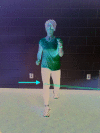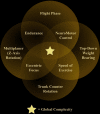FRAMEWORK FOR OPTIMIZING ACL REHABILITATION UTILIZING A GLOBAL SYSTEMS APPROACH
- PMID: 32566384
- PMCID: PMC7297005
FRAMEWORK FOR OPTIMIZING ACL REHABILITATION UTILIZING A GLOBAL SYSTEMS APPROACH
Abstract
Knee injuries such as ACL tears commonly occur and there is a high re-injury rate after primary ACL reconstruction with figures estimated at 25%-33%. Clinicians often use hip strengthening as a key component of knee rehabilitation. Evidence suggests that adopting a "regional" or "proximal" approach to rehabilitation can increase hip strength, but motor control often remains unchanged, particularly during more complex tasks such as running and jumping. It has been previously suggested that the current approach to "regional/proximal" rehabilitation is too basic and is constrained by a reductionist philosophy. This clinical commentary provides the clinician a framework for optimizing knee rehabilitation, underpinned by a more global approach. Although this approach remains hip-focused, it can be easily adapted to modify exercise complexity and key loading variables (speed, direction, flight), which will help the clinician to better replicate the sport specific demands on the knee.
Level of evidence: 5.
Keywords: ACL; dynamic knee valgus; hip exercise; movement system; proximal rehabilitation.
© 2020 by the Sports Physical Therapy Section.
Figures





Similar articles
-
Evidence-based concepts for prevention of knee and ACL injuries. 2017 guidelines of the ligament committee of the German Knee Society (DKG).Arch Orthop Trauma Surg. 2018 Jan;138(1):51-61. doi: 10.1007/s00402-017-2809-5. Epub 2017 Oct 5. Arch Orthop Trauma Surg. 2018. PMID: 28983841 Review.
-
Prevention of non-contact anterior cruciate ligament injuries in soccer players. Part 1: Mechanisms of injury and underlying risk factors.Knee Surg Sports Traumatol Arthrosc. 2009 Jul;17(7):705-29. doi: 10.1007/s00167-009-0813-1. Epub 2009 May 19. Knee Surg Sports Traumatol Arthrosc. 2009. PMID: 19452139 Review.
-
Optimising the 'Mid-Stage' Training and Testing Process After ACL Reconstruction.Sports Med. 2020 Apr;50(4):657-678. doi: 10.1007/s40279-019-01222-6. Sports Med. 2020. PMID: 31782065 Review.
-
Report of the Clinical and Functional Primary Outcomes in Men of the ACL-SPORTS Trial: Similar Outcomes in Men Receiving Secondary Prevention With and Without Perturbation Training 1 and 2 Years After ACL Reconstruction.Clin Orthop Relat Res. 2017 Oct;475(10):2523-2534. doi: 10.1007/s11999-017-5280-2. Clin Orthop Relat Res. 2017. PMID: 28224443 Free PMC article. Clinical Trial.
-
Gait patterns differ between ACL-reconstructed athletes who pass return-to-sport criteria and those who fail.Am J Sports Med. 2013 Jun;41(6):1310-8. doi: 10.1177/0363546513482718. Epub 2013 Apr 5. Am J Sports Med. 2013. PMID: 23562809 Free PMC article.
Cited by
-
Changes in postural stability induced by a ball-and-board game designed from a systems perspective.BMC Sports Sci Med Rehabil. 2025 May 14;17(1):123. doi: 10.1186/s13102-025-01110-9. BMC Sports Sci Med Rehabil. 2025. PMID: 40369646 Free PMC article.
-
Cost-Outcome Descriptive Study for Mobile App (UPSCALER) in the Rehabilitation of Anterior Cruciate Ligament (ACL) Injuries After Reconstructive Surgery.Cureus. 2024 May 8;16(5):e59886. doi: 10.7759/cureus.59886. eCollection 2024 May. Cureus. 2024. PMID: 38854226 Free PMC article.
-
Inter-limb and inter-agent coordination in an original joint-action game: exploring novel approaches for clinical practice.Front Psychol. 2025 Mar 24;16:1514957. doi: 10.3389/fpsyg.2025.1514957. eCollection 2025. Front Psychol. 2025. PMID: 40196205 Free PMC article.
-
Do ACL Injury Risk Reduction Exercises Reflect Common Injury Mechanisms? A Scoping Review of Injury Prevention Programs.Sports Health. 2022 Jul-Aug;14(4):592-600. doi: 10.1177/19417381211037966. Epub 2021 Aug 25. Sports Health. 2022. PMID: 34433324 Free PMC article.
-
How can Blood Flow Restriction Exercise be Utilised for the Management of Persistent Pain Following Complex Injuries in Military Personnel? A Narrative Review.Sports Med Open. 2025 Feb 4;11(1):13. doi: 10.1186/s40798-024-00804-7. Sports Med Open. 2025. PMID: 39900782 Free PMC article. Review.
References
-
- Kaeding CC Leger-St-Jean B Magnussen RA. Epidemiology and diagnosis of anterior cruciate ligament injuries. Clin Sports Med. 2017;36(1):1-8. - PubMed
-
- Ardern CL Taylor NF Feller JA Webster KE. Fifty-five per cent return to competitive sport following anterior cruciate ligament reconstruction surgery: an updated systematic review and meta-analysis including aspects of physical functioning and contextual factors. Br J Sports Med. 2014;48(21):1543-1552. - PubMed
LinkOut - more resources
Full Text Sources
Research Materials
